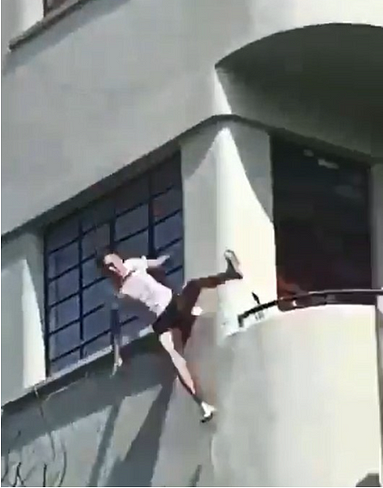The Unsettling Aftermath: Liam Payne's Death, Disturbing Photos, And The Twitter Firestorm
The world was plunged into mourning on October 16th when news broke of Liam Payne's tragic passing. The beloved former One Direction band member, at just 31 years old, died after falling from a hotel balcony in Argentina. Initial reports indicated a fatal fall from a height of approximately 13 to 14 metres, sustaining "very serious injuries incompatible with life." As fans grappled with the shock and grief of losing a talented artist so suddenly, another wave of distress swept across social media, fueled by the controversial publication of disturbing images purporting to show Liam Payne's deceased body.
This article delves into the unfortunate circumstances surrounding Liam Payne's death, the highly contentious decision by celebrity news outlet TMZ to publish graphic photos, and the subsequent furious backlash that erupted across platforms like Twitter (now X), raising profound questions about media ethics, public interest, and the dignity of the deceased.
The Tragic Loss of a Beloved Star
Liam Payne's death sent shockwaves globally. A pivotal figure in the monumental success of One Direction, his solo career had continued to captivate audiences. His sudden demise in Argentina on that Wednesday in October left millions of fans heartbroken and searching for answers. The autopsy report, according to a press release from the Argentina National Prosecutor’s office, confirmed the fall, painting a grim picture of the final moments of a life cut tragically short.
- Tarte Black Friday Sale 2024
- Curler Iron
- Disgusting Ice Cream Flavors
- Ina Garten Sour Cream Cornbread
- Shampoo For Dry Hair And Frizzy Hair
For many, Liam wasn't just a pop star; he was a significant part of their youth, a voice that soundtracked countless memories. The news of his passing, especially under such tragic circumstances, was profoundly difficult to process. But as the initial wave of grief began to settle, a new, unsettling layer was added to the tragedy: the public dissemination of images that no family or fan should ever have to see.
TMZ's Controversial Publication of Post-Mortem Images
At the heart of the ensuing controversy was the American celebrity news website, TMZ. Known for its aggressive pursuit of celebrity scoops, TMZ quickly obtained and published alleged photos of Liam Payne's deceased body after he fell from the Argentina hotel balcony. These images, described as showing parts of the late singer's arm and waist, notably included his tattoos—a clock on his left forearm and a scorpion—which reportedly helped confirm the reports of his death.
The photos were not merely reported; they were published. "TMZ has seen a photo showing Liam's body on the deck at the hotel with tables and chairs nearby," read one account. Another described how "fans who clicked on an alert, a tweet or even a link shared via text, were shocked to see a cropped image of Payne's lifeless body that was included alongside TMZ's reporting." Furthermore, "Photos have emerged of Liam Payne’s body being removed from the hotel in Buenos Aires, Argentina where he died on Wednesday," captured by paparazzi, further amplified the distressing visual content.
- Jessica Alba Curly Hair
- Summer Cute Hairstyles
- Jeremiah Vs Conrad
- Kate Beckinsale Eye Color
- June 14th Horoscope
The decision to publish such explicit and private images of a deceased individual immediately ignited a firestorm of criticism. It wasn't just about reporting the news; it was about the manner in which it was presented, stripping away the last vestiges of dignity from a person who had just met a tragic end.
The Social Media Firestorm: "Shameless," "Irresponsible," and "Gross"
The moment these images hit the internet, particularly spreading rapidly across social media platforms like Twitter (now X), the public outcry was immediate and fierce. "US media and gossip site TMZ sparked fury on Twitter, now X, over publishing photos of the 31-year-old's body." Fans and general users alike were left "enraged" and "absolutely livid."
The sentiment was overwhelmingly negative, with many users on X (formerly Twitter) accusing the outlet of "negligence" by posting the pictures. The language used by the public to describe TMZ's actions was unequivocal:
- "Shameless"
- "Irresponsible"
- "Gross"
- "Disturbing"
- "Harrowing"
"Fans of the late star have been left enraged after a social media account shared disturbing photos of Liam Payne's body, days after he fell to his death from a hotel balcony in Argentina," highlighted the depth of the anger. The backlash wasn't just about the photos themselves, but the perceived lack of respect for Liam, his family, and his grieving fanbase. It was a stark reminder of the power of social media to amplify public sentiment, both positive and negative, almost instantaneously.
Many argued that while celebrity news outlets operate in a realm of public interest, there are fundamental ethical lines that should not be crossed, especially concerning death and privacy. The photos served no journalistic purpose beyond sensationalism, critics argued, and instead inflicted further pain on those mourning.
TMZ's Response and the Broader Debate on Media Ethics
Faced with an unprecedented level of public condemnation, TMZ eventually responded to the uproar. "Celebrity news site TMZ has backtracked after sparking outrage by publishing images of Liam Payne's lifeless body." Reports indicated that "TMZ has come under fire for posting — and then deleting — photos from the scene of Liam Payne’s death Wednesday." Furthermore, "TMZ has retracted explicit images following an uproar after they published photographs of Liam Payne's deceased body."
However, the situation wasn't entirely straightforward. While some images were reportedly removed, an executive producer at TMZ reportedly defended the decision for the news outlet to publish the photos. This defense, though not widely detailed, likely centered on the outlet's usual justification of public interest and factual reporting, perhaps arguing that the images confirmed the circumstances of his death. This stance, however, only fueled further debate about where the line should be drawn between reporting facts and exploiting tragedy for clicks and views.
The Liam Payne incident reignited a long-standing debate within media circles about ethics, privacy, and the sensationalism of celebrity news. In an age where information spreads instantaneously and images can go viral within minutes, the responsibility of news outlets becomes even more critical. Is the public's right to know so absolute that it overrides an individual's dignity in death, or the emotional well-being of their loved ones and fans?
This event serves as a stark case study in the consequences of unchecked media practices and the powerful collective voice of social media. It highlighted the immense pressure on news organizations to deliver content quickly, but also the equally immense pressure from the public to adhere to moral and ethical standards, especially when dealing with such sensitive matters.
The tragedy of Liam Payne's death was compounded by the deeply unsettling public display of his final moments. The furious reaction on Twitter and other platforms underscored a clear message from the public: while there is interest in celebrity lives, there is also a profound expectation of respect, dignity, and empathy, particularly in death. This incident will likely remain a significant point of reference in discussions about media ethics, the boundaries of paparazzi journalism, and the role of social media in holding powerful outlets accountable.
Article Recommendations



Detail Author:
- Name : Kaci Kovacek
- Username : loma.lueilwitz
- Email : sierra.connelly@ondricka.com
- Birthdate : 1986-01-28
- Address : 7696 Issac Spur Roscoeville, NE 24178-9956
- Phone : (385) 765-6137
- Company : Heaney, Kohler and Ziemann
- Job : Restaurant Cook
- Bio : Expedita incidunt non cupiditate assumenda omnis soluta. Ipsam adipisci quia quo iure voluptatem. Adipisci eum labore atque odio vitae veritatis. Sunt accusantium dignissimos aut.
Socials
twitter:
- url : https://twitter.com/nolan.kreiger
- username : nolan.kreiger
- bio : Veniam quas soluta qui quae ducimus qui. Eius autem facere repellendus est id numquam odio aliquid. Minus itaque sint repudiandae eaque aut optio animi.
- followers : 3805
- following : 2218
tiktok:
- url : https://tiktok.com/@nkreiger
- username : nkreiger
- bio : Impedit iusto neque voluptate voluptas minus ex animi.
- followers : 833
- following : 2382
linkedin:
- url : https://linkedin.com/in/nkreiger
- username : nkreiger
- bio : Vero excepturi aliquam cupiditate praesentium.
- followers : 4756
- following : 2703
instagram:
- url : https://instagram.com/nolankreiger
- username : nolankreiger
- bio : Aut est quia consequatur alias commodi inventore. Nam occaecati et aut sed laborum.
- followers : 6598
- following : 1018
facebook:
- url : https://facebook.com/kreiger1987
- username : kreiger1987
- bio : Quisquam vel et rerum ipsum vel. Sint ut quo vel aut ad.
- followers : 2596
- following : 446